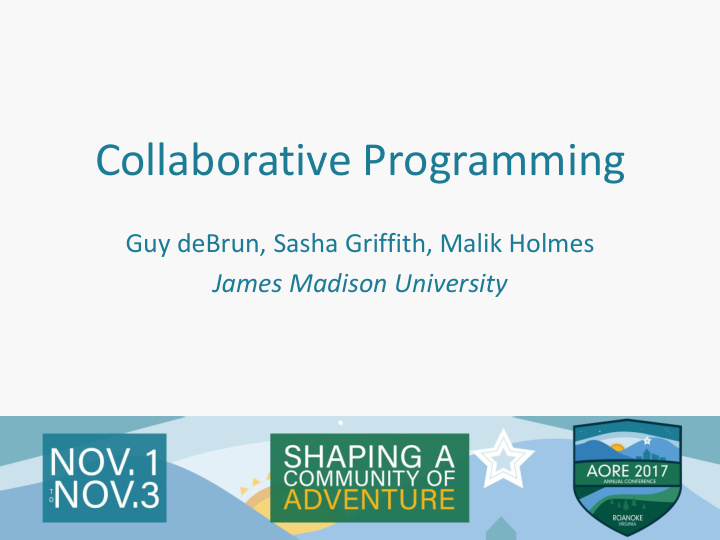



Collaborative Programming Guy deBrun, Sasha Griffith, Malik Holmes James Madison University
Learning Outcomes By the end of this presentation participants will be able to: 1. Explain what is meant by the term Adventure Gap as described by Mills 2. Discuss factors contributing to the Adventure Gap 3. Identify three elements that can increase diversity in outdoor programs.
Partnerships Creating Opportunities Think of ways to connect • In your own department • Across Campus • Reach out
Partnerships In our own Department • Group Exercise (Yoga) • Aquatics (SUP yoga) • Nutrition (cooking with outdoor stoves) • Intramural Sports (Climb the Empire State Building)
Partnerships Across-Campus • Center for Multicultural Student Services (CMSS) • The Counseling Center • Academic Programs • OT Students Research
Partnerships Off-Campus • T/TAC – I’m Determined • Outdoor Nation – Grants and Promotion
Conversation Starters 1. What is the Adventure Gap? 2. What are some outdoor recreation* activities where there is a high percentage of people of color participating? *Outdoor recreation- human powered activities occurring primarily in the natural environment.
Exploring the Adventure Gap “The nation’s wild places—— from national and state parks to national forests, preserves, and wilderness areas —— belong to all Americans. But not all of us use these resources equally. Minority populations are much less likely to seek recreation, adventure, and solace in our wilderness spaces.” -James Edward Mills
Exploring the Adventure Gap There is a racial divide between those who participate in outdoor activities and those who don’t. This is known as the Adventure Gap.
Exploring the Adventure Gap Topline Report 2015 - Outdoor Foundation Youth & Young Adult Demographics (6-24) 2014 a total of 10,778 online interviews were carried out with a nationwide sample of individuals and households
Exploring the Adventure Gap As seen in previous years, participation in outdoor activities was highest among Caucasians in all age groups and lowest among African Americans. In 2014, the largest gap in participation was between Caucasian (65%) and African American (42%) adolescents.
Exploring the Adventure Gap Demographics (6-24) 2013 a total of 19,240 online interviews were carried out with a nationwide sample of individuals and households
An American Ascent Film Trailer https://vimeo.com/102678492
Based on your perspective and/or experiences why does the adventure gap exist?
Exploring the Adventure Gap Activity • Camping trip as a kid • Access to a climbing gym as a kid • Owned specialized equipment (rope, kayak, etc) • Had your own camping equipment • Visited a national park • Saw people like you in outdoor ads • Had someone who looked like you encourage you to participate in climbing, boating, camping, etc.
Reasons for Addressing the Adventure Gap 1. Equal opportunities 2. Conservation a) Majority-minority population by 2042
How can we close the gap?
Reduce Financial Barriers- Guy How are we making outdoor recreation equitable? 1. Reducing financial barriers a) Outdoor Nation Grant
Role Models- Malik Creating role models Campus Ambassador
Data Collection from a Hike in the National Park
Data Collection from a Hike in the National Park
Questions? Guy deBrun- debrungb@jmu.edu Sasha Griffith- griff2sf@jmu.edu
Recommend
More recommend